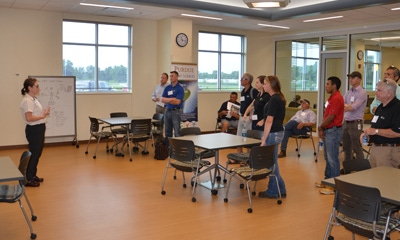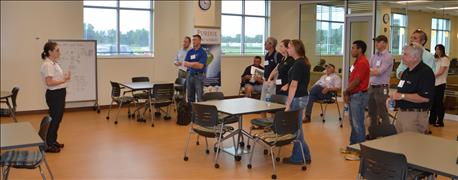
The heart of the new Indiana Corn and Soybean Innovation Center at Purdue University's Agronomy Center for Research and Education (ACRE) could be the big bay that stores the sensor-equipped, high-tech "phenomobile." Or maybe it’s the area of that bay that houses unmanned aerial vehicles of all sizes and styles that will collect almost unimaginable amounts of data from ACRE fields and research plots. Or maybe it’s the state-of-the-art harvesting center where plant breeders and researchers can turn hand-harvested seed into bagged samples for the next step in their development process within a matter of minutes.

SHARE AND SHARE ALIKE: This space was included in Purdue's new Corn and Soybean Innovation Center for one reason — so scientists from different walks of life could rub elbows and share ideas with one another.
It could be any of those things. But the real innovation, the true collaboration among people with different areas of expertise all working toward the same goal, may happen in what appears to be the least high-tech part of the entire center. It’s simply called the Innovation Room.
Karen Plaut, associate dean of the Purdue College of Agriculture and director of ag research, says this spacious room was designed for one purpose. It’s a place where agronomists and engineers, aerospace design specialists and biochemists — anyone with an interest in working with plants or data — can gather and share ideas. This is the place where those "aha" moments will occur, and no one will likely know at the time just how important they may become, she says.
No reservation policy
This isn’t just another conference room. There are plenty of those already on campus and in other locations, Plaut notes. In fact, you can’t even reserve this room for a conference, large or small. The room has a "no reservation" policy.
Instead, it’s for people of different disciplines at Purdue University to come and work together. Some may not know each other until they rub shoulders while working on some aspect of their discipline related to either plants or high-tech sensors and data collection.
There’s a small area next to the room where researchers can get snacks or coffee as they like, but that’s not the purpose of the Innovation Room either, Plaut says. What she and others hope is that when one group of researchers, say plant breeders, are analyzing data and run into a problem, someone else working on data analysis of a different kind, who just happens to be in the room at the same time, may hold the key to unlocking the first group’s dilemma.
It’s called collaboration, and it’s the cornerstone of what Plaut hopes will be the beginning of many breakthroughs in understanding and using plants more efficiently.
Mountains of data
The Indiana Corn and Soybean Innovation Center is all about collecting mountains of data and then figuring out what to do with that data. But most of the data won’t actually be housed at the new center at ACRE. A fiber-optic line will carry data to computers on the Purdue campus, Plaut says. Collection of data will happen in the fields, she says. Data storage will primarily be on the main campus.
What the center is all about is interaction, collaboration and breakthrough conversations like those that led to some of history’s greatest achievements, Plaut concludes.
About the Author(s)
You May Also Like




